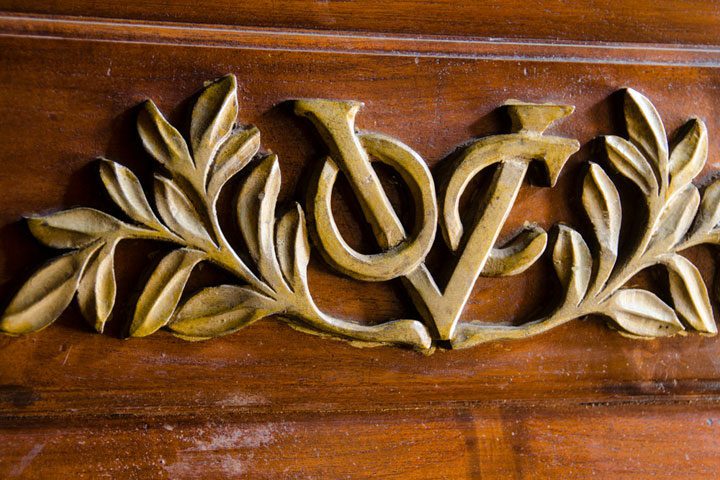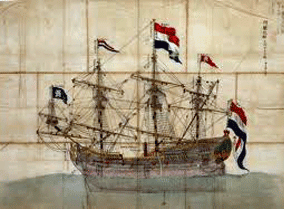Hendrick Indijck: The first Dutchman in Angkor Wat
The Vereenigde Oostindische Compagnie, or the VOC…. As a writer bitten by the history bug, I can never get enough of it.
It was once the largest multinational in the world. A purely profit-oriented company that did not shy away from any means to achieve its goals, but at the same time, as the historian Jan Kuipers noted, produced culture, stimulated voyages of discovery and nautical inventions, and profoundly influenced life in its trading areas and the Republic of the United Netherlands.
A curious mix of mercantilism-hungry merchants, cunning regents, mad adventurers, enterprising seafarers and ruthless soldiers played a key role for almost two hundred years in a huge area that could be situated between the Cape of Good Hope and Japan. In that period, from 1602 to 1795, the Company sent a ship to Asia a total of 4.721 times. A logistics operation that still appeals to the imagination today, involving 972.000 people. Of this huge number, only a third ever returned to their homeland….
One of the men who risked their lives for the VOC was Hendrick Indijck. It is not clear when exactly he was born, but it is true: according to most historians, this happened around 1615 in Alkmaar. Indijck was a literate and adventurous man. After all, before he entered the service of the VOC, this magister in the notarial profession had first worked for a few years as a clerk for the West India Company in Recife in Penambuco, Brazil, shortly after this region had been conquered by the Republic from the Portuguese. However, the indigenous revolt that broke out in 1645 under the leadership of Joao Fernandes Veira shook Dutch authority and after the defeat of the Dutch troops in the Battle of Tabocas (August 3, 1645), Indijck, like many other compatriots, took his rushes and he returned to the Republic.

Cristi Popescu / Shutterstock.com
Apparently he had not yet lost his lust for exotic adventures and on July 12, 1650 he came aboard the Enkhuizen in Batavia as the brand new candidate junior merchant of the VOC. Almost immediately he was allowed to travel on to Ayutthaya because mismanagement had caused the VOC factory in the Siamese capital to get into very difficult papers. Together with the future governor-general Rijcklof van Goens, known for his thoroughness, he arrived in Ayutthaya on November 9 of that same year to put things in order. Together with van Goens, Indyck put an end to the corruption and the skulduggery, put an end to smuggling by the Chinese and restored the trade monopoly with the Japanese. He stayed on the banks of the Chao Phraya for five years. Not entirely against his will, as it turned out, because when his mandate expired, he indicated that he would be happy to stay longer, provided he was promoted to merchant.
When it turned out that people in Batavia were not immediately willing to accede to this request, he took the plunge and sailed to Batavia himself to defend his case. It soon became clear that he would have to wait a while for his promotion. Instead, on May 23, 1656, he was charged with an important mission to Cambodia. After VOC personnel had been massacred earlier, he had to make peace with the Cambodians and reopen the declining trading post. Despite the fever of which he and most of his men fell victim, Indyck managed to arrange the VOC affairs again in a relatively very short period of time. At the same time, he took the opportunity to thoroughly explore the region. Thus, after ten days' journey, part of which in a proa across the immense Tonle Sap Lake, he ended up as one of the first Western visitors in the ruins of Angkor Wat.
From 1617 the directors of the VOC had decided that journals had to be kept of all journeys made. After returning home, these had to be handed in to the VOC, which had an exclusive right to publish this often crucial strategic information. His report on Angkor was the first ever written in Dutch… When Hendrick Indijck returns to Batavia at the end of the same year, he receives his much-coveted appointment as a full-fledged merchant, albeit not in the Indies but back in Cambodia. In the Cambodian capital of Lovek, he took over the Logie, which had been abandoned by the English, and tried to reactivate the largely dead trade from Lovek to the Japanese Shogunate. An important step in the right direction was the conclusion of an agreement under which the VOC 'the exclusive trade in deerskins and other commodities for Japan acquired. In all probability, Maria Quikelenburg, his legal wife, had remained in Batavia because it is certain that he lived in Cambodia with a Khmer woman who bore him two children, Gerrit and Adriaentje. He took these children with him when he became chief merchant in October 1660 at the important VOC post in Deshima, Japan. A lucrative mandate that he fulfilled for almost three years, alternating with business trips to Ayutthaya and Batavia.
On April 2, 1664, he was present in Batavia at the baptism of his daughter Anna from his marriage to Maria Quikelenburg. On April 28, this Alkmaar globetrotter was charged for a third time with a mission to Japan, but Pietje de Dood put a stop to that. Hendrik Indijck, in his life chief merchant at the service of the Patented East India Company died on May 4, 664 in Batavia, probably from malaria. He was buried a day later in the Hollandsch Kerkhof.




Lung Jan, as before, always well written about the VOC period. A fan living in Australia. Yes, I'm sure more stories will come from you in the future. Hopefully this virus loses its strength so wintering can be done again in Thailand. Keep it up Jan and thank you. My complements.
Lovely Lung Jan,
to read this story in one breath and fantasize about whether you were there yourself in the Golden Age.
“A curious mix of mercantilism-hungry merchants, cunning regents, mad adventurers, enterprising seafarers and ruthless soldiers…”
In other words, people with the 'VOC mentality'.
“Of this huge number [972.000], only a third ever returned to their homeland….”
That is not to say that two-thirds died during their VOC employment. I assume it is unknown how many people decided to settle abroad after their VOC time?
In October 1660, he took his children to Deshima. Not a word about his 'mia noi', the mother of his children?
I therefore just think that the VOC granted him a favor to take his children with him. If the mother was still alive, bringing along such a native concubine was probably too much to ask.
Were those two children also taken to Batavia or did they die in Deshima?
Dear Theo,
His 'mia noi' has disappeared in the mists of time. Too bad but unfortunately... The children is a completely different story. Children from a mixed relationship usually ended up in the VOC home in Batavia or Ayutthaya after the father's VOC contract had expired. Especially when the Dutch legal wife was still alive… Indijck not only managed to take them to Deshima, but his son Gerrit even took me on his visits to the Shogun. Which in itself was very unusual. It is equally unusual that Gerrit and his sister Adriaentje suddenly turn up in Amsterdam a few years after Indijck's death and become involved in a lawsuit before the Council of Holland regarding the inheritance of their natural father. His legitimate daughter Anna, as far as I have been able to ascertain, was still in Batavia at that time…
Thanks for this addition Lung Jan.
I am glad that the illegitimate children were not completely left to fend for themselves, but I do not imagine too much of a children's home in those days.
It is indeed very special that such a toddler - because younger than 7 years old - was allowed to accompany us on important visits.
Also that she was a few years later – under 14? – end up in Amsterdam. Such a trip was not cheap.
PS: I read your contributions with above average interest.
Beautiful stories from the VOC archives, but what I would really enjoy: stories of the Siamese, etc. Who was that 'native' Khmer lady, what did she think, what did she do? Unfortunately, the vast majority of the materials from that time were written down by the white-nosed people.
Hi Rob, just read the exact same comment. It came from Tino. Chance?
I suspect indoctrination 😉 ... or a sign that more people think like this. I suspect that Jan himself would also like to see that perspective, but what is not (anymore) is not there, is it? But I'm also happy with what Lung Jan shows us here. 🙂
It is certainly a written piece that appeals to the imagination. Relive other times. I have been recording my family tree for a while now and have already encountered six VOC sailors. All with their own story, but five died according to the VOC's book. (However, the reason is not stated). Often within a year and leaving wife and children behind without money and jewelry. From soldier to cook, everything was on board and often recruited. The iron hand was applied and the punishments on board if violations were committed were not lenient. Even corporal and death penalty. I'm still working on the last VOC sailor, a skipper, and he may have survived.
Watch out. Now the Dutch state has apologized. That they do not hold you as a descendant financially liable for no less than six VOC sailors.
from 1602 to 1795, the Company sent a ship to Asia a total of 4.721 times
I'm bad at math, but.. in 200 years, less than 5000 ships = 25 a year.
They were also months on the road, so what is wrong?
The first years will also have been years of exploration, when people were happy that a ship came back after a year.
I always wonder how people back then communicated and could make contracts that both parties understood.
After reading this interesting story, my first thought was: I am very curious what exactly Hendrick Indijck has written about Angkor. Actually, I had expected some quotes about that, given the title of the piece.
The text suggests that the accounts are there: is that perhaps reason for the writer to make part two in Hendrick's saga? Or are the reports perhaps publicly available somewhere or available as a download?